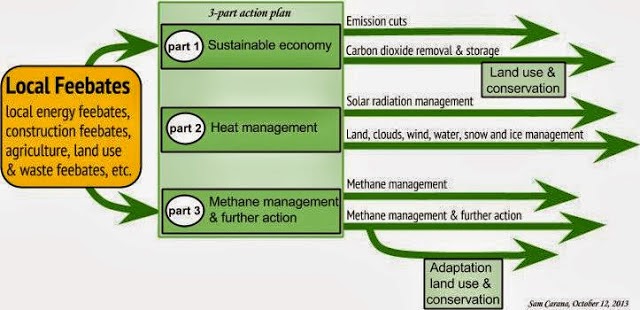Earthquakes in the Arctic Ocean
Earthquakes in the Arctic Ocean
indications of imminent catastrophic methane eruptions?
1. Methane over Greenland
The image below shows high methane concentrations over Greenland and over the Arctic Ocean.
 |
| [ Yellow areas indicate methane readings of 1950 ppb and higher - click on image to enlarge ] |
As described in the post High methane readings over Greenland, huge temperature swings can hit areas over Greenland over the course of a few days. Temperature anomalies may go down as low as as -20°C one day, then climb as high as 20°C a few days later, to hit temperature anomalies as low as -20°C again some days later.
This could explain the methane over Greenland. Methane is present in the Greenland ice sheet in the form of hydrates and free gas. These huge temperature swings are causing the ice to expand and contract, thus causing difference in pressure as well as temperature. The combined shock of wild pressure and temperature swings is causing movement and fractures in the ice, and this enables methane to rise to the surface and enter the atmosphere.
To further illustrate this, the image below shows recent temperature anomaly forecasts over Greenland.
 |
| [ click on image to enlarge ] |
2. What is causing these extreme weather events?
Frigid cold weather in the U.S., torrential rain and flooding in the U.K., and wild temperature swings over Greenland. What is causing these extreme weather events?
As discussed in many previous posts, the Arctic has become warmer than it used to be and temperatures in the Arctic are rising several times faster than global temperatures. This decreases the temperature difference between the areas to the north and to the south of the Jet Stream, which in turn decreases the speed at which the Jet Stream circumnavigates the globe, making the Jet Stream more wavier and increasing opportunities for cold air to descend from the Arctic and for warm air to enter the Arctic.
3. Did temperature swings also trigger earthquakes?
 |
| [ click on image to enlarge ] |
 |
| Topographic map of Greenland without the Greenland Ice Sheet. |
BTW, above map doesn't show all earthquakes that occurred in the Arctic Ocean in March 2014. An earthquake with a magnitude of 4.5 on the Richter scale hit the Gakkel Ridge on March 6, 2014.
Importantly, above map shows a number of earthquakes that occurred far away from faultlines, including a M4.6 earthquake that hit Baffin Bay and a M4.5 earthquake that hit the Labrador Sea. These earthquakes are unlikely to have resulted from movement in tectonic plates. Instead, temperature swings over Greenland may have triggered these events, by causing a succession of compression and expansion swings of the Greenland ice mass, which in turn caused pressure changes that were felt in the crust surrounding the Greenland Ice Sheet.
Glaciers could be the key to make this happen. Glaciers typically move smoothly and gradually. It could be, however, that such wide temperature swings are causing glaciers to come to a halt, temporarily, causing pressure to build up over a day or so, to then suddenly start moving again with a shock. Intense cold can literally freeze a glacier in its track, to be shocked into moving again as temperatures rise abruptly by 40°C or so. This can send shockwaves through the ice sheet into the crust and trigger earthquakes in areas prone to destabilization. The same mechanism could explain the high methane concentrations over the heights of Greenland and Antarctica.
Ominously, patterns of earthquakes can be indicators of bigger earthquakes yet to come.
4. Situation looks set to get a lot worse
This situation looks set to get a lot worse. Extreme weather events and wild temperature swings look set to become more likely to occur and hit Greenland with ever greater ferocity. Earthquakes could reverberate around the Arctic Ocean and destabilize methane held in the form of free gas and hydrates in sediments underneath the Arctic Ocean.
Meanwhile, as pollution clouds from North America move (due to the Coriolis Effect) over the Atlantic Ocean, the Gulf Stream continues to warm up and carry warmer water into the Arctic Ocean, further increasing the likelihood of methane eruptions from the Arctic seafloor.
The above image shows the Gulf Stream off the coast of North America, while the image below shows how the Gulf Stream continues, carrying warmer water through the Atlantic Ocean into the Arctic Ocean.
Feedbacks, such as the demise of the Arctic's snow and ice cover, further contribute to speed up the unfolding catastrophe. Methane eruptions from the seafloor of the Arctic Ocean have become especially noticeable over the past half year. The big danger is that this will develop into runaway global warming, as discussed in the recent post Feedbacks in the Arctic.
Furthermore, as-yet-unknown feedbacks may start to kick in. As an example, submarine earthquakes and volcanoes could add nutrients into the water that feed methane-producing (methanogenic) microbes. A recent study found that expansion of such microbes could have played a large role in the end-Permian extinction, and that it was catalyzed by increased availability of nickel associated with volcanism. Authors support their hypothesis with an analysis of carbon isotopic changes leading up to the extinction, phylogenetic analysis of methanogenic archaea, and measurements of nickel concentrations in South China sediments.
 5. Need for comprehensive and effective action
5. Need for comprehensive and effective actionThe situation is dire and calls for comprehensive and effective action as described at the Climate Plan.
Related
- Methane Release caused by Earthquakes
http://arctic-news.blogspot.com/2013/09/methane-release-caused-by-earthquakes.html
- Seismic activity
http://arctic-news.blogspot.com/p/seismic-activity.html
- Climate Plan
https://arctic-news.blogspot.com/p/climateplan.html










